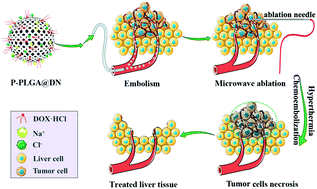Porous PLGA microspheres with recruited ions and doxorubicin for triple-combination therapy of larger hepatocellular carcinoma†
Abstract
Easy recurrence of large hepatocellular carcinoma (HCC) after microwave (MW) ablation or transarterial chemoembolization (TACE) is still very challenging. In this study, porous polylactide-co-glycolide (PLGA) microspheres as a MW-susceptible TACE agent (P-PLGA@DN microspheres) for triple-combination therapy of large HCC were developed via the double emulsion technique using recruited ions (Na+ and Cl−) and doxorubicin hydrochloride (DOX·HCl) to enhance the efficiency of MW absorption and DOX chemotherapy after tumor embolization. The as-prepared microspheres with superior MW-heat conversion can enlarge the ablation area by >53% in a simulated physiological environment. The in vivo efficiencies of chemotherapy and thermal therapy for ICR mice bearing H22 tumor cells under the assistance of P-PLGA@DN microspheres reach to 100%. In the experiments of synergistic therapy combining TACE with MW ablation on VX2 tumor-bearing New Zealand white rabbits, PLGA@DN microspheres can increase ablation area by more than 50%, enhancing the necrosis of tumor cells and effectively inhibiting tumor growth. These results demonstrate that the potential application of P-PLGA@DN microspheres in synergistic therapy of large HCC can be envisioned.



 Please wait while we load your content...
Please wait while we load your content...